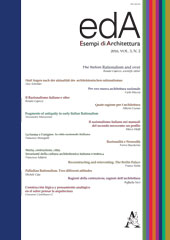Estratto da
ESEMPI DI ARCHITETTURA
International Journal of Architecture and Engineering
Ragioni della costruzione, ragioni dell’architettura. Reasons for construction, reasons for architecture
ESEMPI DI ARCHITETTURA
International Journal of Architecture and Engineering
Ragioni della costruzione, ragioni dell’architettura. Reasons for construction, reasons for architecture

Across history, technical construction has been viewed as the rational phase of architectural designthat could submit forms to its own reasons – actually, a far from universally shared position as manybelieve these reasons are necessary but not sufficient for architecture.Although European rationalism has never placed this argument at the root of its research, this issuebecame particularly important when Italian architecture distanced itself from the International Stylein the postwar years. E. N. Rogers would argue for the necessity of reconciling two words that mustcoexist but should define the ways of their relationship by establishing a new synthesis between thereasons of engineering, represented by remarkable schools and exponents in Italy, and the reasons ofarchitecture.This theme can be recognized in several works by Italian and Milanese architects: Rogers himself withBBPR, Gardella, Albini, Figini and Pollini, among many others who chose to work and experimentwith it in their works.More recently, others decided to explore this issue in order to frame it in theoretical terms. The researchexperiences developed by E. Benvenuto, S. Di Pasquale, A. Monestiroli share a humanist culturalapproach rooted in the Enlightenment that highlights the artistic essence of architecture and, as aresult, the representative goal of its forms. Such goal is the root the architecture’s reasons. The merelyinstrumental role that construction, “the architect’s mother tongue”, would seem to play is vindicated,according to these authors, by a design “intuition” that translates any technical solution into a form,and by the need to “stage” the construction principles and thereby define architecture as a metaphorof construction.
| pagine: | 77-88 |
| DOI: | 10.4399/978885489918612 |
| data pubblicazione: | Dicembre 2016 |
| editore: | Aracne |








